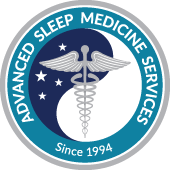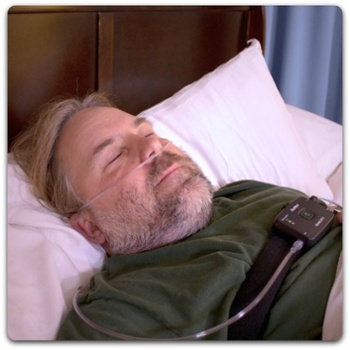Many people suffering with sleep disorders are wary of sleep testing because of the inconvenience (discomfort) of spending the night in a sleep center. In-center testing can also be cost prohibitive, especially with the rise in insurance plan co-pays and high deductibles.
Fortunately, HST—home sleep apnea testing—is providing an increasingly convenient and comfortable alternative to sleeping in a sleep center.
What is the difference between in-center and at-home sleep testing?
In-center testing occurs at either a hospital-based or free-standing sleep center where technicians and advanced sensors are available. The patient is made as comfortable as possible by allowing him to wear his own clothing, observe his normal nighttime routines, and occupy a private room. In-center testing permits detailed monitoring of the patient’s brainwaves, oxygen saturation, leg motion, heart rate, and other critical benchmarks for diagnosing many sleep disorders. A technician oversees the patient throughout the night and sometimes makes adjustments to the equipment setup to ensure the most detailed results possible.
At-home sleep apnea testing (HST) takes place in the patient’s own home. Prior to the test, the patient receives training from a qualified technician on how to use the equipment. The equipment is minimal and usually consists of a nasal sensor, a band that goes around the chest, and a finger clip. When ready to sleep, the patient turns on the device and falls asleep as normal. After the test, the device is returned to the technician for analysis.
What are the advantages of in-center sleep testing?
(1) Detail
The thoroughness of the sensors that are used during an overnight test can detect or rule a variety of sleep disorders, including obstructive sleep apnea, central sleep apnea, narcolepsy and periodic limb movement disorder (learn more about different types of sleep disorders and the studies used to diagnose them here).
(2) Accuracy
The presence of a credentialed and experienced technician and the detailed sensors ensured that the test goes according to plan and you get the data you need. You don’t have to worry about administering the test yourself.
(3) Comprehensiveness
In-center studies can detect all types of sleep disorders and can monitor all types of patients, including children. Furthermore, the presence of a technician ensures the most useful information possible. A technician can initiate CPAP treatment, demonstrate different styles of CPAP masks and experiment with the air flow (called a titration study) all in the same night.
What are the advantages of at-home sleep testing?
(1) Comfort
Taking the test in your own home allows you to sleep in a familiar, comfortable environment. You will receive training from the equipment provider and will administer the test yourself.
Typically, you can go to sleep at your regular bedtime and wake up as usual. If you have to get up throughout the night you can keep the device on.
(2) Accessibility
HST is convenient because you do not have to spend the night in a sleep center, which may not be close to your home or work (FYI, we have over 20 locations across Southern California).
Depending on the equipment provider, you may either pick up the device from the provider or they may mail it to you. You will return the device after testing so that your data can be analyzed and a report is produced.
Home testing is accessible to those who are home-bound, such as the elderly or those with illnesses (however, there are some limitations based on medical conditions, see below).
(3) Cost
Home testing is a fraction of the cost of testing in a lab and is more likely to be covered by insurance. Some insurance companies are now denying requests for in-center sleep studies and approving in-home studies instead. Typically, they will deny a request for in-center testing if there are no significant medical issues and it is highly likely that the patient has moderate to severe sleep apnea.
Which is right for me?
Home sleep testing is recommended if it is highly likely that you suffer from moderate to severe sleep apnea and you have no other significant medical issues.
The following conditions require that you test in-center and not at home (see Journal of Clinical Sleep Medicine Clinical Guidelines for the Use of HST at the bottom of this post):
- You are under the age of 18.
- Your doctor suspects narcolepsy, periodic limb movement disorder, insomnia, circadian rhythm disorder, parasomnias such as sleep walking or REM behavior disorder.
- You have moderate to severe pulmonary disease such as COPD.
- You have neuromuscular disease such as Parkinson’s disease, ALS, muscular dystrophy or multiple sclerosis.
- You have congestive heart failure.
Coverage guidelines vary by insurance plan.
If you suspect that you have a sleeping disorder or think you may require a sleep study, talk to your doctor or sleep specialist to determine which alternative is right for you.
Are you a physician or healthcare provider ready to refer your patients for in-center or in-home testing? Download our service request form (SRF) today to order either in-center or in-home testing:
Are you a patient ready to schedule an appointment for an in-home or in-center test? Click below to get started:
Sources:
http://www.aasmnet.org/resources/clinicalguidelines/030713.pdf
Other posts you may find interesting:
- How Does Sleep Apnea Impant the Brain?
- The Link Between Sleep Apnea and Diabetes
- Which Doctor Should I Talk to About my Sleep Problems?
- How Much Will a Sleep Study Cost Me?
- Why is it Important to Choose an In-Network Provider?
Editor’s Note: This post was originally published in June 2014 and has been edited and updated for accuracy and comprehensiveness.


